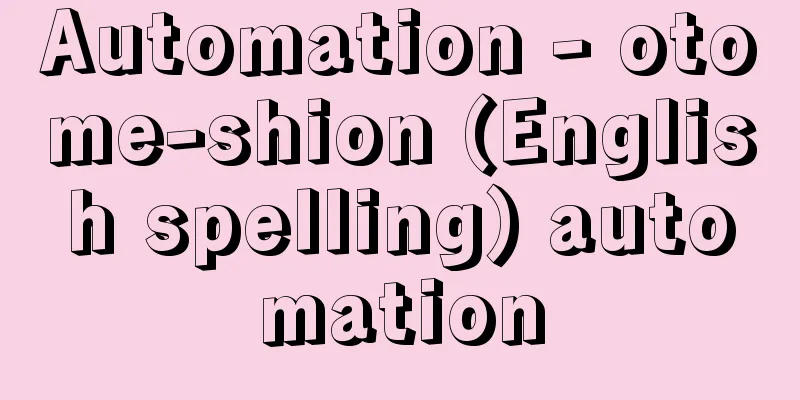Automation - otome-shion (English spelling) automation

|
A mechanical and electrical mechanism that controls the operation of machines on behalf of humans. It is said to have begun in 1948 when Vice President Harder at the Ford Motor Company in the United States named the newly established research department for automating engine processing the Automation Department. It is a newly coined word that combines the abbreviations of "automatic" and "operation." [Hidetaro Nakayama] The road to automationThe beginnings of automatic machinesThe idea of creating something that moves automatically dates back to ancient times. Not only did people invent automatic machines to reduce labor, but they were also interested in things that moved automatically. Around the 1st century BC, Heron of Alexandria created a device that automatically opened and closed temple doors. When a fire was lit on the altar in front of the temple, the air inside the altar expanded due to the heat, pushing water from a container installed under the altar into an adjacent container. The container became heavy and lowered, pulling a rope wrapped around the axis of the door, opening the door. When the fire went out, the air contracted and the water returned to the original container. Another rope wrapped around the axis of the door was pulled by the weight of a stone tied to the end of it, turning the axis in the opposite direction from before, and the door closed. Heron also invented a device that, when a coin was placed in a container filled with holy water installed in a temple, the holy water would flow out from an outlet at the bottom. This was the origin of today's automatic ticket vending machines. The Greek scientist Ctesibius created a water clock that worked automatically. Water flowing into a container slowly raises a float, and the tip of a stick held by a figurine points to the time marked on a cylinder. When the float reaches the top, a siphon drains the water from the cylinder, causing the figurine to drop to the bottom, after which the water begins to push the float up again, repeating the cycle. Archimedes of Greece, who studied screws, devised a device that used a screw to pump water to a high place. A screw was placed inside a cylindrical tube, which was tilted and the bottom end was immersed in water and rotated, causing the water to enter the valley of the screw and gradually move upwards. This is the same as wrapping a hose in a spiral shape around a tube. Among the drawings of Archimedes' screw, there is one that depicts a mechanical device that automatically "moves forever." When the screw is turned, the water rises to a high place and is pumped up into a tank above. The water in the tank flows down from the outlet and turns a water wheel. The axis of the water wheel rotates and turns the screw through a gear mechanism. As the screw turns, the water below is pumped up to the tank above and then falls again to turn the water wheel, so this device is designed to "continue to move forever." Many mechanical devices that could "keep moving forever" were devised after that, including devices that used water moving up a capillary tube, buoyancy, magnets, and gravity, but it was not until the second half of the 19th century that it was realized that it was impossible to create a mechanical device that could keep moving forever without an external supply of energy. [Hidetaro Nakayama] Advances in automated machineryIn 1370, Henry de Vic, a German clockmaker, built a clock to be installed in a church tower in Paris. The clock involved a weight attached to a rope wound around a drum, and the falling weight rotated the drum to move the hands. When the rope around the drum was completely unwound, a person had to turn the drum to wind the rope and lift the weight to the top, but once it was wound up, the clock would run automatically. The important thing here was that the drum had to rotate at a constant speed. The hands needed to rotate at a constant speed. To achieve this, a device was installed that rotated a turnstile via a relief wheel. Small weights were hung on both ends of the turnstile to limit the speed at which the turnstile rotated. The turnstile swung slowly back and forth, so the drum rotated slowly. This device, which was installed to keep the speed constant, was extremely important for an automatically operating machine. However, the speed control method using the turnstile did not work very accurately. Around 1660, the Dutchman Huygens used the isochronism of the pendulum discovered by Galileo to create a more accurate pendulum clock. This clock was also powered by a weight attached to a rope wound around a drum. A little earlier, the German mechanical engineer Peter Henlein (1480-1542) came up with the idea of using a mainspring as the power source. This led to the creation of smaller clocks, which could then be made portable. Once wound, the clock would run automatically and show the time until it was unwound. In 1927, American Warren A. Marison (1896-1980) created a quartz clock that utilized the piezoelectric effect of quartz. Quartz clocks became widespread in the second half of the 20th century, and they became clocks that could run automatically and accurately for about a year using a small mercury battery. [Hidetaro Nakayama] The Beginnings of Automatic ControlIn 1769, British steam engine maker Watt improved on the reciprocating atmospheric steam engine and patented a steam engine with a condenser. In 1781, he invented a planetary gear device to obtain rotary motion from this engine. The steam engine then became widely used as a power source for factories and steam locomotives, and for the next 150 years, it dominated the world of power machinery. The centrifugal governor, invented by Watt in 1788 to keep the rotary motion constant, was one of the major factors that made Watt's steam engine so widely used for such a long time. The governor played an essential role as a control device for automatic machines. When the rotation speed of the ball attached to the rotating shaft increases, it swings outward due to centrifugal force. When the rotation speed decreases, it swings inward and approaches the shaft. The movement of this ball is transmitted by a lever to operate the steam control valve that supplies steam to the steam engine. In other words, when the rotation speed increases to a certain degree and the ball swings outward, the valve closes and the amount of steam decreases. This would slow down the rotation, causing the balls to move inward, and the valves would open, increasing the amount of steam and making the engine rotate faster, so the engine would maintain a constant speed. Thus began automatic control through feedback. In 1830, Andrew Ure (1778-1857) of England invented the bimetal, which is made by bonding two thin metal plates with different coefficients of expansion together. When the temperature changes, the metal with the higher coefficient of expansion stretches more than the metal with the lower coefficient of expansion, so the bonded thin plates bend. This movement of the thin plates can be used to automatically adjust the temperature by opening and closing an electric circuit switch. It is also used to control the temperature of electric kotatsu. [Hidetaro Nakayama] The beginning of the automated factoryIn the second half of the 18th century, flour mills operated all over America, using water wheels as power to turn stone mills, but the work was hard and unclean, with people transporting the flour stepping on it with their shoes on. O. Evans felt that it was necessary to keep these flour mills clean and produce hygienic flour, so he built a flour mill that did not require people to enter the factory. Wheat brought to the top by a bucket conveyor would fall by gravity into a hopper below, where it was ground into flour by stone mills, and the flour that fell to the bottom was packed into bags and sent out. These automated flour mills, which reduced labor and were clean, were established all over America in the 19th century. At the beginning of the 20th century, Ford Motor Company in the United States started mass-producing automobiles. They used conveyor belts to assemble automobiles extremely efficiently. This method soon spread to all departments of machine factories. After the middle of the 20th century, with the development of the electronics industry, electronic control became widespread, and automatic control of machines made great strides. Furthermore, robots with the same senses as the human hand were developed, and automation of production sites progressed rapidly. Robots with not only a sense of touch but also vision were created, and they were combined with electronic machines with the ability to make decisions and remember, and the realization of a fully automated factory that does not require human labor was no longer a dream. Thus, unmanned factories that automatically produce products, a long-held dream of humanity, began operating in the second half of the 20th century. It is expected that humans will be freed from monotonous repetitive tasks, working in high heat, and dangerous jobs, and a society will be realized in which they can concentrate on highly intellectual work that only humans can do. [Hidetaro Nakayama] The automation era is upon usThe word automation is used in a very broad sense and has many stages. For example, an automatic washing machine is a representative example of a low-level system. All you have to do is put the laundry in, set the control mechanism, and turn the switch on. The automatic mechanism built into the washing machine will then wash and rinse the laundry, and when the spin-drying is complete, the switch will automatically turn off, completing the wash. In contrast, the most advanced automation uses machines controlled by computers, which not only control the progress of the machine, but also give appropriate instructions and make decisions to complete the specified operations. An artificial satellite that leaves the Earth is completely controlled by an automatic control mechanism, and can reach the Moon, tens of thousands of kilometers away, land there, and return to Earth after exploration. Engineers are trying to replace human labor with machines. They are trying to eliminate human error, fatigue, heavy labor, etc., and produce faster, safer, and more economically, thereby building a richer society. [Hidetaro Nakayama] Automation kicks offThe Frenchman Basile Bouchon's weaving machine, which was invented to give commands to a machine through a coded control mechanism to automatically perform complex tasks, was the first punch card, which is the basis of today's automation. The movement of the warp threads was controlled by a roll of paper with holes punched in it according to the pattern to be woven, and the pattern was created on the fabric. In 1804, the Frenchman Jacquard improved on this machine and created a pattern loom that controlled 1,200 needles at once with a perforated card. The use of perforated cards gave the machine an effective means of transmitting information. The words that could be transmitted were limited to two words: holes and non-perforated parts. The binary system, based on the number 2, is widely used today for communication by machines. A lot of information can be symbolized by the two words, the "on" and "off" of a light bulb. For example, 32 different information can be transmitted by a combination of five light bulbs being on and off. This not only allows the 26 letters of the alphabet to be represented, but also six other pieces of information, such as punctuation marks. Today, the language of machines is electrical signals rather than light bulbs. [Hidetaro Nakayama] Mechanical AutomationIt was in the 1910s that the American Ford Motor Company began mass-producing automobiles using conveyor belts. To begin this mass production, Ford made technical improvements such as standardizing and simplifying parts to make it easier to work on the conveyor. After World War II, transfer machines made for processing engine blocks brought about a revolution in processing machinery. These machines were equipped with automated machine tools around a conveyor belt, replacing humans. Semi-finished products placed on a moving work table would stop at the machine tool for processing, and would be processed automatically. Once a process was completed, the products would be carried to the next machine, where a different process would be performed automatically. This transfer machine, in which the products were processed one after the other and finally released as finished products, performed all processes automatically, without the need for human labor. Transfer machines that were used to process automobile engine blocks eventually began to be used for other machining processes, leading to the automation of machining processes. Meanwhile, machine tools for small-lot, multi-product production also began to be made. These machines were called numerically controlled machine tools (NC machine tools) and were controlled by punched tape, and the automation of machining progressed even further. In the second half of the 20th century, advances in industrial robots led to even greater automation of machining, with machines being fully automated through electronic machine control, and unmanned factories came into existence. [Hidetaro Nakayama] Process AutomationChemical industries, such as the petroleum industry, chemical fiber industry, chemical fertilizer industry, and cement industry, handle liquids and powders, so they can use pipes for transportation and do not require the complex transportation machines found in mechanical industries. Furthermore, the production process is primarily chemical and physical, and production can be carried out by maintaining the composition, flow rate, temperature, pressure, humidity, concentration, liquid level, etc., according to the purpose. Industries that mainly use such processes are called process industries. In process industries, the process from raw materials to the finished product in the factory is easily carried out using pipes, so it is relatively easy to automate. Another advantage is that it is easy to automatically control temperature, pressure, flow rate, etc. Process automation progressed rapidly after World War II, with the oil refining process now being carried out continuously and temperature and pressure measurement and adjustment now being automated. In oil refineries, the oil refining equipment that distills crude oil into gasoline, kerosene, diesel, heavy oil, etc., as well as other equipment, are automated, with measuring instruments and regulators all gathered in one place and automatically controlled by a control room equipped with graphic panels. There are hardly any people to be seen at the various pieces of equipment spread across the vast site. There are also remote-controlled unmanned hydroelectric and thermal power plants. The turbines and generators are controlled in one central location, and the amount of electricity generated is automatically controlled. Strip mills are also used in steel plants to make thin plates from steel ingots. The steel passes through many rollers, the thickness of the plate is automatically measured, and thin plates of the specified dimensions are automatically produced. [Hidetaro Nakayama] MechatronicsModern mechanical automation and process automation have both made great strides since the 1980s. One of these advances is the increased performance and miniaturization of input sensors (detectors) that take in information and signals. This is largely due to improvements in and new developments in sensor materials, resulting in the emergence of highly functional sensors that are small but can capture a wide variety of information and are now incorporated into products. In addition, there has been a notable improvement in the functional characteristics of electronic circuits that take in information and signals from sensors, calculate, analyze, and judge them according to set procedures, and output signals elsewhere. The miniaturization and integration density of these circuits has increased over the years, leading to the emergence of tiny but highly functional integrated circuits (ICs and LSIs), which have improved product performance and made them more compact, thereby improving convenience. The manufacturing of these highly precise and intensive ICs and LSIs is made possible by Japan's superior production technology and high level of quality control. As exemplified by QC (quality control) circle activities, this is a good example of how the diligence and continuous efforts of the Japanese people have resulted in improved productivity. Additionally, the way information is displayed has changed from neon tubes to LEDs (light emitting diodes) with lower current consumption, and then to LCDs, and the number of screen divisions has increased, resulting in higher resolution. Meanwhile, the drive mechanisms (actuators and mechanisms) that receive input signals and perform other tasks have also been made smaller and lighter overall, going from the large and heavy structures made up of the previous combination of mechanical elements, and this is largely due to the emergence of small, powerful electric motors. It goes without saying that similar examples can also be seen frequently in home electrical appliances and automobiles. This set of technical fields is called "mechatronics," and it can be said to be an optimal combination of the three hardware elements mentioned above - sensors, electronic circuits, and mechanisms - and software such as information and signals. Mechatronics has already become commonplace in modern machines, and is closely related to our daily lives. This reality is very familiar when we look at the multi-function ticket vending machines and automatic ticket gates installed in large numbers at railway stations, as well as magnetic recording tickets, and the like, where the systemization of technology stimulates the development of other technologies and contributes greatly to their realization. The functionality of products continues to improve every day, but it is said that new product development requires a flexible combination of creative design and rich production technology. One of the hit products in recent years is the mobile phone. It is a small yet highly functional communication device, and the fact that it allows you to communicate with others anywhere can be said to be revolutionary. However, this product also has unexpected pitfalls, and not only has it caused a decline in the morals of its users, but it has also been highlighted in society for its lack of consideration for pacemaker patients. It goes without saying that this communication device is very convenient, but it cannot be denied that it has also played a role as a trigger for engineers to be questioned about their ethics and responsibility in the development and realization of new technology. These two types of automation have enriched and enhanced our lives, but at the same time, they have also called for a more ethical approach to technology. This issue is a good example of how technological progress always creates new challenges. [Ichiro Tsutsumi] Business AutomationIn 1880, the population of the United States was 50,262,000. It took seven years to count the population in the census at that time. Since then, the population has increased, so it was doubtful whether the 1890 census could be counted in 10 years. It was Hollerith who solved this difficult problem. He coded the census information, created a recording device using punch cards, and processed it mechanically. As a result, the results were able to be obtained in just two years, even though the population had increased by 25%. This recording device was later improved and developed into today's electronic calculating machines. Factories and companies have a variety of clerical tasks, such as sorting invoices, calculating employee payroll, cost accounting, sales analysis, tallying production output, purchasing materials, and inventory management. Previously, all of these tasks were done manually, but with the development of electronic computers, these processes can now be done mechanically. Statistical machines used for censuses and other purposes are now useful as statistical machines for company office use, and statistical machines specifically for office use have been made, which can automatically classify, calculate, and tally. In banking, the use of cards allows deposits and withdrawals to be made instantly and automatically, and recently it has become possible to use terminals at the branches of other affiliated banks. The automation of office processing using information processing devices such as computers, facsimiles, word processors, and data communication systems is called office automation (OA). In contrast, systems that control household chores, education, safety, energy, and other aspects of the home are called home automation (HA). [Hidetaro Nakayama] Quality improvement through automationFrom a production standpoint, it goes without saying that it is easier to produce a small variety of cars in large quantities, and from an economic standpoint, it also allows for low prices. A typical example of this can be seen in the story of Henry Ford, when he started mass-producing automobiles, he limited the number of car models to one type, the T-shaped model, and the only color available, black. Many people were satisfied with that and were able to own a car, but once that was satisfied, it was only natural that people would want a different model or color than others. It was only natural that other companies would gradually increase the number of models and colors available as part of their product strategies to meet these needs (demands). Once this sales battle was satisfied to a certain extent, people would then want a special car that only they could have, and this history follows a cycle of product pursuit between buyers and suppliers, and between companies. This phenomenon is not limited to automobiles, but similarities can be seen in other product developments as well. The recent trends and current state of automation have been mentioned above, but what is particularly interesting is the improvement in the quality of products and production equipment. While mechatronics is the main focus, the actual management of production has made significant use of computers to achieve this. Numerous computers are used everywhere, including manufacturing process management, product inspection, and inventory management, and the system has been put into place to accumulate and utilize data from the product design stage to the drawing of the results, functioning over a wide range of areas. Many of the machine tools that are the actual carriers of production are also computer-controlled, and by inputting processing information transferred from the design room, products can be completed in a short amount of time. Another recent trend is that the products produced by these production facilities now have a wide variety of added value that was not seen before. When we look at precision equipment such as watches and cameras, we see that many functions are built into small products. These are made possible by highly accurate sensors and highly integrated electronic circuits, and we need to recognize anew the existence of high-level production technology and quality control based on the ingenuity of the Japanese people that has made such functional designs possible. Society's needs have always demanded better things, more convenience, and more functionality, and engineers and companies have made repeated efforts to meet these demands. This accumulation becomes technological potential energy for further development. The continued production of products is premised on consumption, and economic development that depends on repeated consumption would be impossible without the existence of resources and energy that are the basis of product production. The foundation of modern automation is deeply connected to resource and energy issues and global environmental issues, and it can be said that it depends on how production can continue while coexisting with these issues. [Ichiro Tsutsumi] Sociality of control functionsControl forms can be broadly divided into feedback control and feedforward control. The former regulates input based on the results (output) obtained, while the latter regulates input by predicting the results (output). As in the treatment and prevention of pathology, these forms of control appear repeatedly in our daily lives, but most people seem to be barely aware of this. In general, human actions accumulate information and experience as data, sort and classify this data, and try to respond appropriately to the next activity or situation. Therefore, failures can be said to be invaluable data. In the past, technical failures were not made public, and only success cases were published and evaluated as results. Rather, in the future, it is possible that the creation of a system that makes failures a shared technical asset and effectively utilizes them as data will become a social need. The current economic situation has led to the integration of competing companies, and as a result, the sharing of difficult technical data accumulated in past experiences is becoming a reality. In order to ensure the maintenance of production in the future, it can be said that a system is required to optimally combine and execute the ideas seen in the two control forms mentioned above according to the purpose. To do this, it is important to build a flexible information system that can carefully observe the process of human thought and action from the perspective of control, classify the results obtained from it according to the purpose, and search and use them. Although production equipment once assembled cannot be easily changed, it is expected that the challenge of optimizing the production process by skillfully combining flexible ideas is more important than ever in the automation field. FMS (flexible manufacturing system) is one good example of this. FMS is a system that can flexibly respond to design changes, and is also called a flexible production line. For example, to increase productivity in high-mix, low-volume production, NC machine tools, automatic tool changers (ATC = automatic tool changers), automatic workpiece attachment/detachment devices, unmanned transport devices, etc. are controlled by computers to provide flexibility in the work content. Considering the short life span of products, a system that can adapt to slight changes in production is set up. [Ichiro Tsutsumi] The pros and cons of automationThe development of automation technology, which has been mentioned so far, is one bright spot. It is also true that the more this technology advances, the more the workplaces that previously relied on a large number of skilled workers will become narrower. It cannot be denied that the introduction of new technology has caused rapid changes in the work environment, which has become evident as a social problem. The realization of a high level of automation will cause the skilled workers who have been responsible for manufacturing sites to lose and lose the skills they have accumulated over the years. Japan's economic structure is also deeply involved in this, and the current situation in which production sites themselves are being sent overseas to Southeast Asia and China is unavoidable. Highly skilled workers are getting older with each passing year, and the assets of their skills are finding no way to revive them. Automation technology has enriched society by producing products at low prices in large quantities, streamlining and systematizing production, making products more multifunctional and responsive, and making them more compact. However, it can now be said that the technology is at a crossroads as to what kind of environment it will continue to exist in the 21st century. [Ichiro Tsutsumi] Automation and Modern SocietyAutomation and the Workforce: The ProblemThe productivity of labor increases not only with the way labor is coordinated and organized, but also with the introduction of more advanced technology (the system of labor means). This is the purpose of the introduction of automation. It completely changes not only the quality of labor but also the way workers coordinate and organize. With mechanization that began with the Industrial Revolution, the processing of raw materials was mainly made by machines, and workers were engaged in tasks such as setting and operating individual machines according to the purpose and object of work. Workers began to work on machines, and the content of their work changed. The advances in automation using mechanical mechanisms further changed the content of work. Workers began to perform tasks such as monitoring, checking, and adjusting machine processing, and were distant from direct labor to the object of work. This transformation of labor has progressed even further with the introduction of automated machine tools with computers and transport systems controlled by computers. At this point, these automation has not exceeded the delicate movement of human hands, but by writing the skills and experience of skilled workers into computer programs, machines instead of humans automatically make sequential decisions and perform tasks. As a result, workers' roles have been auxiliary tasks such as monitoring automated machine tools and robot groups, operating centralized control equipment, refining installation errors, and maintenance. The advances in automation have been aimed at eliminating the monotonous repetitive labor caused by the conventional flow-based work method, and de-manned factories. They have also achieved labor savings, uniformity and speed up processing, improved quality, and improved equipment utilization rates, dramatically improving labor productivity. Furthermore, workers are being released from work in adverse environments such as pollution and danger. Furthermore, the emergence of systems that support tasks that consider complex conditions and the analysis and inference of large amounts of information has been made possible by realizing computer-integrated production (CIM), including the computerization of design work (CAD), production, distribution, sales, management strategies, etc., and online delivery from orders to manufacturing and shipping, and by operating terminals to make orders and materials orders sufficient. The introduction of Internet technology has progressed digitalization of information such as development, production, sales, maintenance and repair, and efficient responses through mutual negotiations on the network, saving management resources and achieving agile corporate management. However, this automation and digitalization of production does not necessarily lead to improvements in the content and conditions of work or improvements in life for workers. Not only does it increase labor density due to increased utilization rates and speeds, but it also causes health disorders caused by mental stress, such as long mental tensions due to agility to automatic control and monitoring work, alienation caused by work surrounded by automated machine tools and robots, and loss of motivation to work due to deskilling work. Furthermore, the advancement of automated equipment technology and black boxing calls for even greater advancement of the intellectual and technical operation capabilities of the workers involved. As a result, the shifting of middle-aged and older workers who are not good at acquiring these abilities and the risk of unemployment. At the same time, it has created new technical workers who are engaged in intellectual labor such as development, management and maintenance of support systems, programming, software creation, data entry work, and more, increasing temporary workers, subcontractors, and temporary employment. Furthermore, the development of automation is increasing the number of research workers responsible for research and development of the high-tech technologies that make up this. These changes in labor composition will force the changes to Japanese labor-management relations, such as seniority-based wages and lifetime employment, but they will basically reduce the number of workers involved in material production and increase the number of workers involved in mental production. [Tomohiro Hyodo] Automation and EducationAutomation, or "automation," has attracted the attention of educators as a direction to suggest a future vision of education. The idea that educational activities, especially teaching subjects in classrooms, has traditionally been dominated by human teachers, has been the dominant idea that education automation can be said to be an attempt to seek a major revision to the preconceived notion that "teachers do" to date. になったんです。 English: The first thing you can do is to find the best one to do. The third factor that promotes the automation of education is the connection to the ongoing information technology (IT) revolution on a global scale. ITization of finance and industry is about to change Japan's economy and industrial structure, but it is expected that the ITization of education will bring about changes comparable to structural changes in the economy and industry in the field of education. Specifically, it is the introduction of internet lines to schools, the nationwide development of optical fiber networks, the launch of BS (broadcast satellite) digital broadcasting, the digitalization of terrestrial television, and the "information highway concept" in local communities, incorporating CATV (cable television) networks. Rapidly developing information technology is trying to contribute significantly to the nationwide expansion of business opportunities beyond existing industry-specific boundaries and improving convenience for local residents. The advanced information and communication society, which is formed around IT, will inevitably encourage significant deregulation in the communications field. The fusion of information technology, consisting of telecommunications, terrestrial television, BS digital broadcasting, and the Internet, is making the numerous regulations surround the Japanese communications field obsolete. The automation of education will play a part in the ongoing IT revolution, and it is believed that structural changes in education in Japan will also be realized in conjunction with the progress of the IT revolution in the future. [Nishimoto Yoichi] "Kamibayashi Sadajiro and Sasagawa Gizaburo, Capitalist Automation and Socialist Automation" (1958, Chuo Keizaisha)" ▽ "Ishida Kazuo, Theory of Modern Corporations and Labor (1967, Minerva Shobo)" ▽ "Yamada Keiichi, Theory of Modern Technology (1969, Asakura Shoten)" ▽ "H. Braevaman, translated by Tomizawa Kenji, Labor and Monopoly Capital" (1978, Iwanami Shoten)" ▽ "Philip Hills, Translated by Isobe Takeo, Communication and Education (1982, Taga Publishing)" ▽ "Kamata Keizai, The Site of the Robot Age" (1983, Sanichi Shobo)" ▽ "Kenmoji Kazumi, The Microcomputer Revolution and the Future of Labor" (1983, Nihon Hyoronsha)" ▽ "Tanaka Hirohide, Skills to Dismantle" (1984, Nihon Keizai Shimbun Co., Ltd.)" ▽ "Wakuda Hiroaki and Hitomi Katsuto's "FA & OA" (1984, Nikkan Kogyo Shimbunsha)" ▽ "Hayashi Yoshio and Noro Kageyasu, "Unmanned System" (1984, Nikkan Kogyo Shimbunsha)" ▽ "Nakayama Shutaro, "History of Machine Development" (1987, Taiga Publishing)" ▽ "Nishinozono Haruo and Inoue Kazuo, "Computers that Make Use of Lessons" (1988, Gyosei)" ▽ "Kinoshita Susumu, "FA Robot Technology Innovation and Human Resource Development" (1988, Kaibundo)" ▽ "Invitation to CAI" (1989, Doshoin)" ▽ "L.T.C. Rolt, translated by Isoda Hiroshi, "History of Machine Tools: From Craftsman's Skills to Automation" (1989, Heibonsha)" ▽ "Honbayashi Katsumi, "50 Check Notes on Production Management to Realize High-Various Small Volumes and Just-In Time" (1989, PHP Institute)" ▽ "Hitomi Katsuhito, "The Theory of Production Systems: Technology and Management of Modern Production" (1990, Dobunkan Publishing)" ▽ "Aomizu Tsukasa, "Informationization and Engineers" (1990, Aoki Shoten)" ▽ "Onogi Hiroaki, "Exploring Education Methods and Techniques: An Approach to Educational Engineering and Educational Psychology" (1991, Nakanishiya Publishing)" ▽ "Shimizu Yasutaka et al., "Education in the Information and Communication Age" (1992, Society of Electronics, Information and Communication Engineers)" ▽ "Inoue Tomoyoshi, "Education Engineering: An Approach from Cognitive Psychology" (1993, Cytech)" ▽ "Paul Kennedy, translated by Suzuki Shuu, "In preparation for the 21st Century Difficulties" (1993, Soshisha)" ▽ "Yamamoto Kiyoshi, "Technology and Labor History in Japan in Japan - 1854-1990" (1994, University of Tokyo Press)" ▽ "Onuma Masanori, "Iwanami Civic University: Thinking about the History of Humanity (12) Technology and Labor" (1995, Iwanami Shoten)" ▽ "Takagi Akira, "Contemporary Automation and Economics: An Introduction to the Study of Modern Capitalism" (1995, Aoki Shoten)" ▽ "Matsuda Mitsuaki, "Introduction to Workflow Automation - Work Savvy People Starring" (1996, Doyukan)" ▽ "Morita Toichiro, "Automation and Labor Organization" (1997, Tax Accounting Association)" ▽ "Yokonoyoshi, "Research on Modern Corporate Labor - Focusing on the technological development and the perspectives of labor and management" (1997, Horobunsha)" ▽ "Introduction to Labor Science" (1997, Kitaoji Shoten)" ▽ "Miyata Yoshinori, "ME Innovation and Japan's Labor System" (1998, Hitosha)" ▽ "Matsuishi Katsuhiko, "Computer Controlled Production and Giant Monopoly Enterprises" (1998, Aoki Shoten)" ▽ "Editor of Yamaguchi Eiichi, Takahashi Masami and other editorial committee members, "Encyclopedia of 21st Century Computer Education" (1998, Shunpo)" ▽ "Kusuda Yoshihiro, "Automatic Systems Guide to Knowing the Tips for Automation Systems" (1998, Nikkan Kogyo Shimbun Co., Ltd.)" ▽ "Readings: Japanese Labor (11) Technological Innovation" (1999), edited and published by Japan Institute of Labor Research (1999), " ▽ "Illustrated Guide to Introduction of Industrial Robots" (1999, Nikkan Kogyo Shimbun Co., Ltd.)" ▽ "Okamoto Toshio, "Educational Information Engineering in the Internet Age" (2000, Mori Publishing)" ▽ "Advances in the absence of humanity: The message of new technology, unemployment, and resistance" by David F. Noble, translated by Watanabe Masao et al. (Kobushi Shobo)" (Kobushi Shobo)" (2001, Kobushi Shobo)" (2001, Nakaoka Tetsuro, Suzuki Jun, Tsutsumi Ichiro, and Miyaji Masato, History of Industrial Technology (2001, Yamakawa Publishing)" (2001 , Yamakawa Publishing)" (2001, Automation by Nakayama Shutaro (Iwanami Shinsho)" (2002, Moritani Masaru's Delusions of the IT Revolution" (Bunshun Shinsho)" [References] | | | | | | | | | | | | | | | | | | | | | | | | | | | | |An automatic opening and closing device for temple doors, devised by the ancient Greek engineer Heron. When the altar is lit with fire, the air inside the altar expands, pushing the water inside the hollow ball at the bottom into the bucket. When the bucket drops with the weight of the water, the rope wrapped around the door shaft and the door opens. When the fire goes out, the water in the bucket returns to the ball, the weight drops, and the door closes ©Shogakukan "> Heron's automatic door opening/closing device ©Shogakukan "> The flow to automation in factories Source: Shogakukan Encyclopedia Nipponica About Encyclopedia Nipponica Information | Legend |
|
機械の操作を人間にかわって制御する機械的・電気的機構。1948年、アメリカのフォード自動車会社で、新しく設けたエンジン加工の自動化の研究部門に対して、副社長ハーダーがオートメーション部と名づけたのが始まりといわれている。オートマチックautomaticとオペレーションoperationを省略して結合した新造語である。 [中山秀太郎] オートメーションへの道自動機械の芽生え自動的に動くものをつくろうという考えはかなり古くからあった。労働を軽減するために自動機械をくふうしただけではなく、自動的に動くものに興味をもっていたのである。アレクサンドリアのヘロンは紀元前1世紀ごろに、神殿の扉を自動的に開閉する装置を製作した。神殿の前にある祭壇に火をともすと、祭壇の中の空気が熱によって膨張し、祭壇の地下に仕掛けてある容器に入っている水を隣の容器に押し出す。その容器は重くなって下がりながら、扉の軸に巻き付けてある綱を引っ張り、扉を開くのである。火が消えると空気は収縮し、水はもとの容器に戻る。扉の軸に巻き付けてある別の綱は、その端に結び付けてある石の重みで引っ張られて、扉の軸を前とは逆方向に回し、扉は閉まるのである。またヘロンは、寺院に備え付けてある聖水を入れた容器に貨幣を入れると、下の出口から聖水が流れ出す装置もくふうした。今日の自動切符販売機の元祖である。 ギリシアの科学者クテシビオスは自動的に動く水時計をつくった。容器に流れ込む水が浮きを徐々に持ち上げ、人形が手に持っている杖(つえ)の先端が円筒に記された時刻をさすようになっている。浮きがいちばん上まで押し上げられると、サイフォンによって円筒内の水は外に排出され、人形はいちばん下まで降りてしまい、ふたたび水が浮きを押し上げる運動を繰り返す。 ねじを研究したギリシアのアルキメデスは、ねじを利用して水を高所にくみ上げる装置をくふうした。円筒形の筒の中にねじを入れたもので、これを斜めにし下方を水の中につけて回転させると、水はねじの谷の中に入り、しだいに上方に移っていく。これは、ホースを筒に螺旋(らせん)状に巻き付けたものと同じである。このアルキメデスのねじを描いた絵の中に、自動的に「永久に運動する」機械装置を表したものがある。ねじを回転すると、水は高所に登っていき上のタンクにくみ上げられる。タンクの水は出口から下に流れ落ちて水車を回す。水車の軸は回転し歯車装置でねじを回すようになっている。ねじが回れば下方の水は上方のタンクにくみ上げられ、また落下して水車を回すということで、この装置は「永久に動き続ける」仕掛けになっている。 「永久に動き続ける」機械装置は、その後も数多く考えられた。毛細管を上っていく水を利用したもの、浮力を利用したもの、磁石を利用したもの、重力を利用したものなどいろいろあるが、外からエネルギーを供給しないで永久に動き続ける機械装置は実現不可能ということは、19世紀後半になるまでわかっていなかった。 [中山秀太郎] 自動機械の進歩1370年ドイツの時計師ド・ビックHenry de Vicは、パリで教会の塔に据え付ける時計を製作した。ドラムに巻き付けた綱におもりを取り付け、おもりの落下によるドラムの回転を利用して針を動かすものであった。ドラムに巻き付けてある綱が全部ほどけたときには、人間がドラムを回して綱を巻き、おもりをいちばん上まで持ち上げるという手仕事はあったが、いったん巻き上げれば、あとは自動的に時計は動く。ここで重要なことは、ドラムの回転を一定速度にしなければならないことである。指針は一定の速さで回る必要がある。そのために逃し車を経て回転木戸を回す装置がついている。回転木戸の両端には小さな分銅が下がっていて、回転木戸の回る速度を制限している。回転木戸が左右にゆっくりと振れるので、ドラムはゆっくりと回る。速度を一定にするためにつけられたこの装置は、自動的に動く機械にとってきわめて重要であった。しかし、回転木戸による速度制御方法はそれほど正確には動かなかった。 1660年ごろオランダのホイヘンスは、ガリレイの発見した振り子の等時性を利用して、より正確に動く振り子時計をつくった。この時計も、ドラムに巻き付けた綱に取り付けたおもりによって動くものであった。これよりすこし前ドイツの機械技師ヘンラインPeter Henlein(1480―1542)は、ぜんまいを動力とすることを考えた。これによって時計はしだいに小形となり、携帯用のものがつくられるようになった。ねじを巻けば、それがほどけ終わるまで時計は自動的に動き、時刻を示した。 1927年アメリカのマリソンWarren A. Marison(1896―1980)は、水晶のピエゾ電気効果を利用した水晶時計をつくった。20世紀後半には水晶時計が普及し、小さな水銀電池で約1年間自動的に、そして正確に動き続ける時計となった。 [中山秀太郎] 自動制御の初めイギリスのワットが往復動大気圧蒸気機関を改良し復水器(コンデンサー)付き蒸気機関の特許をとったのは1769年であり、この機関から回転運動を得るために1781年、遊星歯車装置を考案した。そして蒸気機関は工場用動力、蒸気機関車としてその利用範囲は広まり、以後150年間、動力機械の王座を占めることとなった。回転運動を一定にするために1788年にワットの発明した遠心調速機は、ワットの蒸気機関がかくも長期間広く利用された一つの大きな要素であった。調速機は自動機械にはなくてはならない制御装置としての役割を果たすものであった。回転軸に取り付けた球は、回転が速くなると遠心力によって外側に振れる。回転が遅くなると、内側に向かい軸に近づく。この球の運動をレバーによって伝え、蒸気機関に送り込む蒸気調節弁を動かすようにしたのである。すなわち、回転がある程度速くなり球が外側に振れると、弁は閉じて蒸気の量を少なくする。そうすると回転は遅くなって球は内側に動く、弁は開いて蒸気の量は増え回転が速くなるというぐあいで、蒸気機関はある一定の速度を維持することになる。かくしてフィードバックによる自動制御が始まったのである。 1830年イギリスのユアAndrew Ure(1778―1857)は、膨張係数の異なる二つの金属の薄板を貼(は)り合わせたバイメタルを考案した。温度が変化すると、膨張率の大きい金属は小さい金属よりもよけいに伸びるので、貼り合わせた薄板は湾曲する。この薄板の動きを利用して、電気回路のスイッチを開閉することにより温度を自動調節することができる。電気こたつの温度の制御などにも利用されている。 [中山秀太郎] 自動工場の初め18世紀後半アメリカの各所で動いていた製粉所は、水車を動力とし石臼(いしうす)を回していたが、仕事は重労働で、粉を運搬する人が土足で粉を踏むなど不潔でもあった。O・エバンズは、この製粉工場を清潔にし、衛生的な小麦粉をつくらなければならないと考え、工場内に人が入らなくともよい製粉工場を建設した。バケットコンベヤーで最上部に運び込まれた小麦は、重力で下方のホッパーに入り、石臼で粉にされ、下部に落ちた小麦粉は袋に詰められて出ていくという工場にした。労働を軽減し、清潔なこの自動製粉工場は、19世紀に入るとアメリカの各所に設立された。 20世紀の初めアメリカのフォードは自動車の大量生産を開始した。ベルトコンベヤーを使用し、自動車の組立てをきわめて能率よく行うものであった。この方法はやがて機械工場のあらゆる部門に普及した。20世紀のなかばを過ぎると、電子工業の発達に伴って電子式制御が普及し、機械の自動制御は飛躍的発展をした。さらに人間の手と同じような感覚をもつロボットも開発され、生産現場の自動化は急速に進んだ。触覚だけでなく視覚をもつロボットもつくられ、さらに判断・記憶の能力をもつ電子式機械と組み合わせられ、人手の要らない完全自動工場の実現も夢ではなくなった。かくして人類長年の夢であった自動的に生産を行う無人工場が20世紀の後半に稼動することとなった。人間は単調な繰り返し作業、高熱下での仕事、近寄ると危険な仕事などから解放され、人間でなければできない高度な知的仕事に専念できる社会の実現が期待される。 [中山秀太郎] オートメーション時代の到来オートメーションということばはきわめて広い意味に使用され、多くの段階がある。たとえば自動洗濯機は程度の低い段階のものの代表といえよう。洗濯物を入れ、制御機構をセットし、スイッチを入れれば、あとは、洗濯機内に組み込まれている自動機構によって洗われ、水洗いが行われ、脱水が終わればスイッチが自動的に切れて、洗濯が完了する。それにひきかえ、もっとも高度なオートメーションはコンピュータにより制御される機械を使用したもので、機械の進行を制御するだけでなく、適当な指示を与えたり判断をし、所定の動作を完了するようにできている。地球を飛び立った人工衛星は、自動制御機構により完全に制御され、何万キロメートルも離れた月に到達し、そこに着陸し、探査後ふたたび地球に戻ることができるのである。技術者は人間の労働を機械に置き換えようと努力している。人間の誤り、疲労、重労働などを除き、より速く、安全に、そして経済的に生産をし、豊かな社会を築き上げようとしている。 [中山秀太郎] オートメーションの開幕記号化された制御機構で機械に命令を与え、複雑な仕事を自動的に行うようにくふうしたフランスのブーシャンBasile Bouchonによる織物機械は、今日のオートメーションの基本となっているパンチカードの最初であった。織り出すべき文様どおりに孔(あな)のあけられた一巻きの紙により縦糸の動きが制御され、織物に文様がつくられていくようになっていた。この機械を改良し、一度に1200本の針を孔あきカードで制御する文様織機を製作したのは、1804年フランスのジャカールであった。孔あきカードを使用したことは、機械に有効な情報伝達手段を与えたというわけである。伝達のことばは、孔と、孔のない部分との2語に限られていた。2を基本とした二進法は今日機械による伝達に広く使用されている。電球の「点」と「滅」との二つで多くの情報を記号化できるのである。たとえば、5個の電球の点・滅の組合せにより32通りの情報伝達ができる。これによってアルファベット26文字を表せるばかりでなく、句読点など、なお6個の情報が伝えられる。現在では機械のことばとして、電球ではなく電気信号が使われている。 [中山秀太郎] メカニカル・オートメーションアメリカのフォード自動車会社が、ベルトコンベヤーを使用して自動車の大量生産を開始したのは1910年代のことであった。この大量生産を開始するにあたってフォードは、部品の規格化、単純化を行い、コンベヤー上での作業を容易にするなど技術的改良も行った。 第二次世界大戦後、エンジンブロック加工用につくられたトランスファーマシンは、加工機械に革命をもたらした。この機械は、ベルトコンベヤーの周りに、人間にかわって自動工作機械を配置したものであった。動く作業台の上にのった半製品は、加工用工作機械の位置で停止し、自動的に加工が行われ、一つの作業が終わると次の加工機械の位置まで運ばれ、ここでさらに別の加工が自動的に行われる仕組みとなっていた。次々と加工が行われ最後に完成品となって出ていくこのトランスファーマシンは、人手を使わずすべての作業が自動的に行われるものであった。 自動車のエンジンブロック加工に使われたトランスファーマシンは、やがて他の機械加工にも使用されだし、機械加工の自動化が進んだ。 一方、多品種少量生産用の工作機械もつくられるようになった。この機械はパンチテープなどにより制御される数値制御工作機械(NC工作機械)とよばれ、機械加工の自動化はよりいっそう進んだ。20世紀後半に入ると、工業用ロボットの進歩により、機械加工の自動化はさらに高度となり、電子機械による制御で完全に自動化し、無人工場も出現することとなった。 [中山秀太郎] プロセス・オートメーション石油工業、化学繊維工業、化学肥料工業、セメント工業などの化学工業は、液体、粉体などを扱うため、搬送にはパイプが使えるので、機械工業におけるような複雑な搬送機械は要らない。また生産工程は化学的・物理的処理が主となり、組成、流量、温度、圧力、湿度、濃度、液位などをそれぞれ目的に応じた条件に保つことにより生産が行える。このような工程を主体とする工業をプロセス工業とよんでいる。プロセス工業では、工場内の原料から製品までの工程がパイプなどで流しやすくされているので、自動化するのは比較的容易である。また温度、圧力、流量などの自動制御も簡単にできる利点がある。 石油精製の工程が連続的に行われ、温度、圧力の測定、調節が自動化されるなど、プロセス・オートメーションは第二次世界大戦後急速に進んだ。石油精製工場では、原油からガソリン、灯油、軽油、重油などを分留する石油精製装置をはじめとし、その他の装置も自動化され、計測器、調節器を1か所に集めグラフィックパネルを備え付けた管理室によって自動制御されている。広い敷地にある各種の装置には人影をほとんどみない。 水力発電所、火力発電所でも、遠隔操作による無人発電所がある。タービンや発電機の制御を1か所で集中的に行い、発電量を自動的に制御しているのである。また製鉄工場などでも、鋼塊から薄板をつくったりするのにストリップ・ミルが使われ、多くのローラーの間を通り、板厚は自動的に測定され、所定の寸法の薄板が自動的に生産されるようになっている。 [中山秀太郎] メカトロニクス現代のメカニカル・オートメーションとプロセス・オートメーションはいずれも、1980年代以降長足の進歩がみられる。その一つに、情報や信号を取り入れる入力側のセンサー(検出器)の高性能化と小型化があげられる。これにはセンサー用材料の機能向上と新たな開発が大きく貢献し、小さいながらも多種多様の情報が取り込める高機能センサーが登場し製品にも組み込まれている。さらに、センサーから情報や信号を取り込み、それらを定められた手順に従って演算・解析・判定し、他に信号を出力する電子回路の機能特性向上も顕著である。この回路の小型化と集約密度は年を追って高まり、微小ながらも機能に優れた集積回路(ICやLSI)が登場、製品性能向上とコンパクト化を実現し、利便性の向上を果たした。 こうした高精度な集約度の高いICやLSIの製造には、日本の優れた生産技術と高レベルの品質管理がその背景に存在する。QC(品質管理)サークル活動に代表されるように、日本人の勤勉さと継続努力の成果が、生産性向上に結実したよい事例といえよう。 加えて、情報の出力表示もネオン管からより電流値の少ないLED(発光ダイオードlight emitting diode)、さらに液晶などに変わり、画面分割数の増大による高解像度が実現した。一方、入力信号を受けて他に何らかの仕事をする駆動機構(アクチュエータとメカニズム)も、従来の機械要素の組合せによる大きくて重い構造から、全体的な小型軽量化が達成されたが、これは小型で強力な電動機の出現に負うところが大きい。こうした事例が家庭電化製品や自動車にもよくみられることは、いうまでもない。 これら一連の技術分野は「メカトロニクス」とよばれるが、これまで述べたセンサー、電子回路、機構という三つのハードウェアと、情報や信号などのソフトウェアを最適に組み合わせた一つの姿といえる。現在の機械ではメカトロニクスがすでに常識となり、私たちの日常生活と密接にかかわっている。鉄道の駅に多数設置される多機能形乗車券販売機や自動改札機、さらに磁気記録乗車券などをみてもこうした現実は実に身近であり、技術のシステム化が他の技術の開発を刺激し、その実現に大きく貢献している姿である。製品のもつ機能向上は日々続けられているが、新製品開発には創造性に裏付けされた設計と、豊かな生産技術の柔軟な組合せが必要といわれている。 近年におけるヒット商品の一つに、携帯電話がある。小さいながらも高機能な通信機器で、場所を選ばず相手と交信できることは画期的といえよう。しかしこの製品にも思わぬ落とし穴があり、使用者側のモラル低下もさることながら、ペースメーカー装置者への配慮不足も社会的にクローズアップされている。この通信機器の利便性はいまさらいうまでもないが、技術の新たな開発と実現においては技術者の倫理と責任が問われるトリガー(引き金)の役割を果たしたことも、否定できない。 これら二つのオートメーションは、私たちの生活を豊かにし充実させはしたが、その反面で技術の倫理観を要求したともいえる。この問題は技術の進歩がつねに新たな課題を創出するという好事例といえよう。 [堤 一郎] ビジネス・オートメーション1880年アメリカの人口は5026万2000人であった。このときの国勢調査でこの人口を集計するのに7年の年月を要した。その後人口は増加したので、1890年の国勢調査では集計が10年でできるかどうか危ぶまれていた。この難問を解決したのはホレリスであった。国勢調査の情報を記号化し、パンチカードによる記録装置をつくって、機械的に処理したのであった。その結果、人口は25%増加していたにもかかわらず、わずか2年間で結果を出すことができた。このときの記録装置はその後改良され、今日の電子式計算機械へと発展したのである。 工場や会社では、伝票の整理、従業員の給料計算、あるいは原価計算、販売分析、生産高の集計、資材の購入、在庫管理などさまざまな事務的仕事がある。これらは従来すべて手作業であったが、電子計算機の発達により、その処理を機械的に行うことができるようになった。人口調査などに使われた統計機械が会社の事務用統計機械として役だち、事務専用の統計機械もつくられ、分類、計算、集計が自動的に行えるようになった。銀行業務でもカードの使用によって、入金、引出しが即時に、自動的にでき、最近では、提携関係にある他の銀行の各支店の端末機も使えるようになった。 コンピュータ、ファクシミリ、ワードプロセッサー、データ通信システムなどの情報処理機器を活用し、事務処理の自動化を行うことを、オフィスオートメーション(OA)とよんでいる。それに対して、家庭内の家事、教育、安全、エネルギーなどをコントロールするシステムをホームオートメーション(HA)という。 [中山秀太郎] オートメーションにみる質的向上生産面からみれば、少品種多量生産がやりやすいことはいうまでもなく、経済面からみても低価格が実現できる。この典型はヘンリー・フォードが自動車の大量生産を始めたとき、車種をT形一種類にし、色は黒だけにしたという話からも納得できる。多くの人々はそれで満足し自動車を持つことができたが、ひととおりそれが充足されると今度は他人とは異なる車種や色が欲しくなるのはごく自然な成り行きといえる。こうしたニーズ(要求)を満たすべく他社が商品戦略で車種や色を少しずつ増やして顧客のニーズにこたえるのは当然である。この販売合戦もあるところまで充足すると、今度は自分だけが持っている特別な自動車が欲しくなるという、購買側と供給側相互さらに企業間での商品追求が繰り返されるといった歴史をたどる。こうした現象は何も自動車に限らず、他の製品開発においても相似性がみられることである。 近年に至るオートメーションの動向と現状は先に述べたが、とりわけ興味深いのは製品と生産設備の質的向上ではなかろうか。基本的にはメカトロニクスが中心だが、この実現を図るため実際の生産管理面ではコンピュータの援用が著しい。製造プロセス管理、製品検査、在庫管理など、至る所にたくさんのコンピュータが使われており、製品設計の段階からその結果を図面化する段階まで、データの蓄積と利用面でシステム化され広範囲に機能している。生産の実際の担い手である工作機械もその多くがコンピュータコントロール化され、設計室から転送された加工情報を入力し、短時間で製品が完成するまでになった。 こうした生産設備から生み出される製品にも、従来にはないさまざまな付加価値が数多くみられることも近年の特徴である。時計やカメラといった精密機器をみても、実にたくさんの機能が小さな製品のなかに組み込まれている。これらはとりもなおさず高精度のセンサーと高度に集積化された電子回路によるが、こうした機能設計を実現させた日本人の独創性に基づく高い生産技術と品質管理の存在を、私たちは改めて認識する必要があろう。 社会のニーズはつねによりよいもの、便利なもの、機能に富んだものなどを要求し、技術者も企業もそれを満たすべく努力を重ねてきた。この蓄積はさらなる発展のための技術面でのポテンシャルエネルギー(潜在的エネルギー)になる。製品を製造し続けることは消費が前提であり、消費の繰り返しに依存する経済発展は製品生産の基となる資源やエネルギーの存在なくしては不可能である。現在のオートメーションの根幹は、資源・エネルギー問題と地球環境問題に深くかかわり、これらといかにして共存しながら生産を続けるかにかかっているといえよう。 [堤 一郎] 制御機能の社会性制御の形態は、フィードバック制御とフィードフォワード制御に大別できよう。 前者は得られた結果(出力)をみて入力を調節するもの、後者は結果(出力)を予測して入力を調節するものである。病理面での治療と予防のように、私たちの日常生活ではつねにこれらの制御形態が繰り返し登場するが、多くの人々はこうしたことをほとんど自覚していないように思われる。 一般に人間の行動は情報や経験をデータとして蓄積し、このデータを整理分類し次の活動や事態に適切に対応しようとする。それゆえ失敗はまたとない大切なデータといえる。従来は技術面での失敗は表面化させず、成功事例だけを成果として公表しまた評価がなされてきた。むしろ今後は失敗を技術面での共有財産となし、これらをデータとして有効活用するシステムづくりが社会的ニーズになる可能性をもつ。現在の経済情勢は競争企業相互間の統合を生み、その結果として、これまでの経験に蓄積された得がたい技術データの共有も現実化しつつある。今後の生産を確実に維持するためには、前述の二つの制御形態にみられる考え方を目的にあわせて最適に組み合わせ実行する体制づくりが求められているといえよう。そのためには人間の思考と行動の過程を制御という面からよく観察し、そこから得られた成果を目的に沿わせて分類し検索・使用できるフレキシブル(柔軟)な情報のシステム構築が大切である。ひとたび組み上げた生産設備は簡単には変えられないが、柔軟性に富んだ考え方を巧みに組み合わせ生産の過程に適用し最適化を図ることは、オートメーション分野では従来にも増して大切な課題になると予想される。 FMS(flexible manufacturing system)はこのよい事例の一つである。FMSとは、設計変更に柔軟に対応できるシステムのことで、フレキシブル生産ラインともいう。たとえば多品種少量生産での生産性を高めるため、NC工作機械、工具自動交換装置(ATC=オートマチック・ツール・チェンジャー)、工作物自動着脱装置、無人搬送装置などをコンピュータで統括制御して作業内容に柔軟性をもたせるのである。製品寿命が短いことを考慮して、多少の生産の変更に適応できるシステムが組まれている。 [堤 一郎] オートメーションの光と影これまで述べたオートメーション技術の展開は、その光の部分である。この技術が進めば進むほど、従来多数の熟練技能者に頼っていた労働の場が狭められることもまた事実である。新技術導入が労働環境の急速な変更を引き起こし、社会問題として顕在化してきたことも否定できない。高度なオートメーション化の実現は、ものづくり現場を自らが担ってきた熟練技能者に、長年蓄積された熟練技能の低下と損失を引き起こすのである。これには日本の経済構造も大きく関与し、生産の場そのものが東南アジアや中国に海外流出する現状は避けて通れない。高度な熟練技能者は年を追うごとに高齢化し、彼らがもつ技能という財産は復活の場をみいだせないでいる。 低価格で大量に製品をつくりだし、生産の合理化とシステム化、製品の多機能化と迅速対応、さらにコンパクト化などを実現し社会に潤いを与えたこれまでのオートメーション技術は、21世紀においてどのような環境でその存在を継続していくのか、現在は大きな岐路にたっているといえよう。 [堤 一郎] オートメーション化と現代社会オートメーションと労働者――その問題点労働の生産性は、労働の協同・編成の仕方によって高まるが、より進化した技術(労働手段の体系)の導入によっても向上する。オートメーションの導入の目的はここにある。この導入は労働者の労働の質はもちろん、協同・編成の仕方をも一変させる。 産業革命に始まる機械化によって、原料の加工は機械が主となり、労働者は作業目的・対象に応じた個々の機械の設定・操作などの作業に従事することになった。労働者は機械に対して労働を行うようになり、その労働内容は変わった。そして、機械的機構による自動化の進展は、さらに労働内容を変化させた。もっぱら労働者は機械による加工の監視・確認・調整などの作業を行うようになり、作業対象への直接的な労働から遠ざかった。 このような労働の変容は、コンピュータを組み込んだ自動工作機械やコンピュータによって統御された搬送システムなどの導入によっていっそう進んだ。これらの自動化は、いまのところ人間の手指の繊細な動きを超えるには至っていないが、熟練した労働者の技能や経験をコンピュータ・プログラムに書き込むことで、人間のかわりに機械が自動的に逐次、判断し、作業を実行するようになりつつある。そのため労働者の役割は、自動工作機械やロボット群の監視、集中制御機器の操作や取り付けミスの手直し、メンテナンスなどの補助作業となった。 オートメーションの進展は、これまでの流れ作業方式による単調な反復労働を解消し、工場の無人化を志向するものである。また省力化、加工の均一化・高速化、品質の向上、設備稼働率の向上を実現し、労働の生産性を飛躍的に向上させた。さらに、汚染・危険などの悪環境下での作業から労働者を解放させつつある。 なお、複雑な条件を考えあわせる作業や大量の情報の分析・推論を支援するシステムの登場は、設計作業のコンピュータ化(CAD(キャド))をはじめ、生産、流通、販売、経営戦略などを包含したコンピュータ統合生産(CIM)を現実のものとし、受注から製造、出荷までのオンライン化を進め、注文や資材発注を端末機を操作することで事足りるようにした。そして、インターネット技術の導入は、開発、生産、販売、保守・修理等の情報のデジタル化を進め、ネットワーク上での相互交渉による効率的対応を実現し、経営資源の節約や機敏な企業経営を実現しつつある。 しかしながら、こうした生産の自動化・デジタル化は、かならずしも労働者にとって労働内容・条件の改善、生活の向上につながるものではない。稼働率・稼動速度のアップによる労働の高密度化のみならず、自動制御への敏捷(びんしょう)な対応や監視業務による長時間の精神的緊張、自動工作機械やロボットに囲まれた作業による疎外感、脱熟練化に伴う作業の無内容化による労働意欲減退など、精神的ストレスを原因とする健康障害を引き起こすものでもある。 また、自動化された機器の技術の高度化、ブラックボックス化は、これに携わる労働者の知的能力、技術操作能力のいっそうの高度化を要求する。その結果、これらの能力の習得を不得手とする中高年労働者の配置転換、失業のおそれを生み出している。その一方で、支援システムの開発・管理・保守、プログラミングやソフトウェアづくり、データ入力作業等の知的労働に従事する新しい技術系労働者を生み出し、派遣労働者や下請、臨時雇用を増大させている。また、オートメーションの発展はこれを構成するハイテク技術の研究開発を担う研究労働者を増大させつつある。 こうした労働構成の変化は、これまでの年功的序列賃金、終身雇用などの日本的労使関係の変更を迫るものであるが、基本的には物質的生産に携わる労働者を減少させ、精神的生産に携わる労働者を増加させるものである。 [兵藤友博] オートメーションと教育オートメーションすなわち「自動化」は、教育の未来像を示唆する一つの方向として、教育関係者の注目を集めてきた。もともと教育活動、なかんずく教室における教科の学習指導は、伝統的に人間教師が担当するものという考え方が現在に至るまで、支配的である。教育の自動化はこの「授業は先生がするもの」という、これまでの既成概念に大きな修正を求める試みといえよう。 教育の自動化の実現は次の三つの要因に依存している。その第一は、20世紀の後半になって進歩の著しい諸科学(行動主義心理学、認知心理学、大脳生理学、電子工学、情報処理教育等々)の研究成果が積極的に教育自動化の試みに役だてられるようになったことである。教育の自動化のプロセスの科学的解明と併行して、もう一つの重要な展開は、優れた性能をもつ電子計算機の出現である。教育の自動化を実現するためのツール(道具)として電算機は特別の意味をもつ。人間教師の介在にとらわれない学習指導システムを立ち上げるにはコンピュータによる学習指導プロセスのシステマティックな制御が不可欠である。CAI(学習指導の機器システムComputer-Assisted Instruction)は学習指導の自動化の試みの本命ともいうべきものである。周知のようにコンピュータによる学習指導は多様な学習プログラム(学習ソフト)の開発を前提とする。CAIの普及につれて、学校教育、成人教育用の優れた学習ソフトが現在、続々と開発されつつある。 教育の自動化を促進する第三の要因は、地球規模で現在、進行中の情報技術(IT)革命とのつながりである。金融や産業のIT化は、日本の経済・産業構造を大きく変えようとしているが、教育のIT化も経済や産業の構造変革に匹敵する変革を教育の分野にもたらすものと予想される。具体的にはインターネット回線の学校への導入や、光ファイバー網の全国整備、BS(放送衛星)デジタル放送の開始、地上波のデジタル化、さらにはCATV(ケーブルテレビ)網を取り込んでの「情報ハイウェイ構想」の地域社会における先導的試みである。急速に発展する情報技術は、既存の業種別の枠を越えた商機の全国的拡大や地域住民の利便性の向上に大きく貢献しようとしている。 ITを軸にして形成される高度情報通信社会は、一方において通信分野の大幅な規制緩和を必然的に促すこととなる。電気通信、地上波およびBSデジタル放送、インターネットなどで構成される情報技術の融合が、日本の通信分野に張り巡らされている数々の規制を時代遅れのものとしつつある。 教育のオートメ化は、現在、進行しているIT革命の一翼を担うもので、日本における教育の構造的変革も今後のIT革命の進捗(しんちょく)と連動して実現していくものと考えられる。 [西本洋一] 『上林貞治郎・笹川儀三郎著『資本主義オートメーションと社会主義オートメーション』(1958・中央経済社)』▽『石田和夫著『現代企業と労働の理論』(1967・ミネルヴァ書房)』▽『山田圭一著『現代技術論』(1969・朝倉書店)』▽『H・ブレイヴァマン著、富沢賢治訳『労働と独占資本』(1978・岩波書店)』▽『フィリップ・ヒルズ著、磯辺武雄訳『コミュニケーションと教育』(1982・多賀出版)』▽『鎌田慧著『ロボット時代の現場』(1983・三一書房)』▽『剣持一巳著『マイコン革命と労働の未来』(1983・日本評論社)』▽『田中博秀著『解体する熟練』(1984・日本経済新聞社)』▽『涌田宏昭・人見勝人著『FA&OA』(1984・日刊工業新聞社)』▽『林喜男・野呂影勇著『無人化システム』(1984・日刊工業新聞社)』▽『中山秀太郎著『機械発達史』(1987・大河出版)』▽『西之園晴夫・井上和郎著『授業を活かすコンピューター』(1988・ぎょうせい)』▽『木下進著『FA・ロボット技術革新と人材育成』(1988・海文堂)』▽『菅井勝雄著『CAIへの招待』(1989・同文書院)』▽『L・T・C・ロルト著、磯田浩訳『工作機械の歴史――職人の技からオートメーションへ』(1989・平凡社)』▽『本林勝海著『多品種少量・ジャストインタイムを実現する生産管理の50のチェックノート』(1989・PHP研究所)』▽『人見勝人著『生産システム論――現代生産の技術とマネジメント』(1990・同文舘出版)』▽『青水司著『情報化と技術者』(1990・青木書店)』▽『大野木裕明著『教育の方法と技術を探る――教育工学・教育心理学からの接近』(1991・ナカニシヤ出版)』▽『清水康敬他著『情報通信時代の教育』(1992・電子情報通信学会)』▽『井上知義著『教育工学――認知心理学からのアプローチ』(1993・サイテック)』▽『ポール・ケネディ著、鈴木主税訳『21世紀の難問に備えて』(1993・草思社)』▽『山本潔著『日本における職場の技術・労働史――1854~1990年』(1994・東京大学出版会)』▽『大沼正則著『岩波市民大学 人間の歴史を考える(12)技術と労働』(1995・岩波書店)』▽『高木彰著『現代オートメーションと経済学――現代資本主義論研究序説』(1995・青木書店)』▽『松田光明著『ワークフロー・オートメーション入門――業務精通者が主役』(1996・同友館)』▽『森田統一郎著『オートメーションと労働組織』(1997・税務経理協会)』▽『幸光善著『現代企業労働の研究――技術発展と労働・管理の視点を中心に』(1997・法律文化社)』▽『千田忠男編著『労働科学論入門』(1997・北大路書店)』▽『宮田義典著『ME革新と日本の労働システム』(1998・批評社)』▽『松石勝彦著『コンピュータ制御生産と巨大独占企業』(1998・青木書店)』▽『山口栄一編集代表、高橋正視ほか編集委員『21世紀コンピュータ教育事典』(1998・旬報社)』▽『楠田喜宏著『自動化システム心得ノート』(1998・日刊工業新聞社)』▽『日本労働研究機構編・刊『リーディングス 日本の労働(11)技術革新』(1999)』▽『楠田喜宏・八木喬著『図解 産業用ロボット導入実践ガイド』(1999・日刊工業新聞社)』▽『岡本俊雄著『インターネット時代の教育情報工学』(2000・森出版)』▽『デービッド・F・ノーブル著、渡辺雅男他訳『人間不在の進歩――新しい技術、失業、抵抗のメッセージ』(2001・こぶし書房)』▽『中岡哲郎・鈴木淳・堤一郎・宮地正人編『産業技術史』(2001・山川出版社)』▽『中山秀太郎著『オートメーション』(岩波新書)』▽『森谷正規著『IT革命の虚妄』(文春新書)』 [参照項目] | | | | | | | | | | | | | | | | | | | | | | | | | | | | |古代ギリシアの技術者ヘロンが考案した神殿の扉の自動開閉装置。祭壇に火がともされると祭壇内の空気が膨張し、下部にある中空球の中の水をバケツ内に押し出す。バケツが水の重みで下がるとき、扉の軸に巻き付けられたロープを引き、扉が開く。火が消えると、バケツの水は球の中に戻っておもりが下がり、扉は閉じる©Shogakukan"> ヘロンの自動扉開閉装置 ©Shogakukan"> 工場における自動化への流れ 出典 小学館 日本大百科全書(ニッポニカ)日本大百科全書(ニッポニカ)について 情報 | 凡例 |
Recommend
Multimedia - Multimedia (English spelling)
A system that converts information such as animat...
Geophilomorpha
...A general term for arthropods belonging to the...
Amentia - Amentia (English spelling)
The term has a broad meaning; in the UK it means ...
Territorial sea - Ryokai (English spelling)
A strip of sea along the coast that has a certain...
Article - Kanshi
A type of short word that combines with a noun or...
Mao Shan School - Mao Shan School (English)
A sect of Chinese Taoism. It is also called the Ma...
Worcester
The county seat of Worcestershire, in the mid-west...
Demand-shift inflation
...So a new explanation was needed for why prices...
Aggreman (music) - Aggreman
…The masters of keyboard music of the time, Jean ...
Ealing Comedy
…(6) The Archers, founded in 1943 by M. Powell an...
Adenet le Roi (English spelling)
A 13th century French author (Trouber). Date of bi...
Epallaginidae
…The Yaeyama Hanadaka dragonfly, a rare species f...
Santa Cruz (English spelling)
It is the second largest city in Bolivia and is lo...
Sveinsson, A.
...However, in terms of visual arts, not many not...
Frog - Frog
A general term for the order Anura in the class Am...









